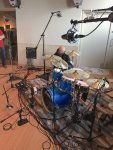Reggae_Mangle
Silver Member
Hey all, hope you had a Very Merry Christmas and a Happy New Year! I know I did!
I'm interested in laying down some drum tracks at my home. I'm not confident enough to pay for a studio just to waste time going over drums over and over.
I will be using a TD30 kit with Superior Drummer 3. I think the sound part of things is pretty much sorted. I am used to the kit, having learnt how to play using it.
The sound side of things sorted out, I have really been struggling with the recording process in itself.
1) For one, I hate having to set a metronome pre-count, rush to my seat while counting and then begin where I need to. This really kills the flow of my performance because I sometimes take more time and sometimes less time to get settled behind the kit.
Is there a better way to do this than rushing after I click record with the pre-count going?
2) I have so far focused my energies on trying to lay down perfect tracks in one go from end-to-end. This is fun, but after take 5 or 6 of a six or seven minute track, I feel like I've burnt up a lot of energy and while some parts are fantastic, others have drifted or there are glitches.
I am really keen to avoid having to look at the midi track and then manipulate notes and velocities and stuff like that.
In that respect, how many of you record in stages? I saw Chris Adler doing it in the studio and I thought that looks promising.
Better for a studio recording than going from end-to-end? This is kind of a moot point since a perfect take from end to end is just very difficult with my skills.
3) When you record bit-by-bit, what is the process like? Do you just start the recording before the start of the next part and then cut and glue so that the transition is seamless? Or do you record the track a few times and comp? Adler seemed to use the former method, but he had a studio guy. I think I'll go crazy if I have to keep going back and forth just to record short sections.
What if I record till a point where things go screwy, then go back a bit and record again for a while till it becomes screwy, etc, till I reach the end of the track? Does that make sense? Or is the sequential approach the best, kind of like groove sections?
4) When you do record bit-by-bit, is there any copying and pasting going on? Or do I record each part sequentially without worry about whether they sound exactly the same? How do you studio cats do it?
I'm interested in laying down some drum tracks at my home. I'm not confident enough to pay for a studio just to waste time going over drums over and over.
I will be using a TD30 kit with Superior Drummer 3. I think the sound part of things is pretty much sorted. I am used to the kit, having learnt how to play using it.
The sound side of things sorted out, I have really been struggling with the recording process in itself.
1) For one, I hate having to set a metronome pre-count, rush to my seat while counting and then begin where I need to. This really kills the flow of my performance because I sometimes take more time and sometimes less time to get settled behind the kit.
Is there a better way to do this than rushing after I click record with the pre-count going?
2) I have so far focused my energies on trying to lay down perfect tracks in one go from end-to-end. This is fun, but after take 5 or 6 of a six or seven minute track, I feel like I've burnt up a lot of energy and while some parts are fantastic, others have drifted or there are glitches.
I am really keen to avoid having to look at the midi track and then manipulate notes and velocities and stuff like that.
In that respect, how many of you record in stages? I saw Chris Adler doing it in the studio and I thought that looks promising.
Better for a studio recording than going from end-to-end? This is kind of a moot point since a perfect take from end to end is just very difficult with my skills.
3) When you record bit-by-bit, what is the process like? Do you just start the recording before the start of the next part and then cut and glue so that the transition is seamless? Or do you record the track a few times and comp? Adler seemed to use the former method, but he had a studio guy. I think I'll go crazy if I have to keep going back and forth just to record short sections.
What if I record till a point where things go screwy, then go back a bit and record again for a while till it becomes screwy, etc, till I reach the end of the track? Does that make sense? Or is the sequential approach the best, kind of like groove sections?
4) When you do record bit-by-bit, is there any copying and pasting going on? Or do I record each part sequentially without worry about whether they sound exactly the same? How do you studio cats do it?


